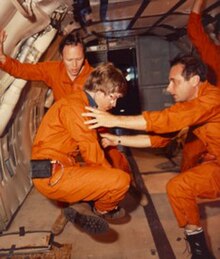Space sickness

Space sickness is the discomfort that space travelers experience until their bodies have adapted to weightlessness . Like seasickness , space sickness is caused by a disturbance in the organ of equilibrium .
Space sickness practically did not occur during the first space flights as these flights took place in very cramped conditions. It is amplified when one is able to move around freely and is therefore more common in larger spacecraft. About 70 percent of all space shuttle astronauts experienced them during their first flight. The first case in space travel, as one now suspects, occurred in 1961 with German Titow , who reported dizziness and nausea. The first noticeable cases occurred on the early Apollo flights. Frank Borman on Apollo 8 and Russell Schweickart on Apollo 9 both had distinct and moderately severe cases of space sickness; at Schweickart this resulted in a change in the operational plan.
As with seasickness, symptoms can range from mild nausea and disorientation to vomiting and severe malaise; Headaches and nausea of varying intensity are often reported. Around half of those with the disease have mild symptoms, only around ten percent suffer a lot.
Modern seasickness drugs also work against space sickness, but are rarely used. It is believed that it is better for the astronauts to get used to weightlessness for a few days than for them to be exposed to the side effects of medication during the duration of their mission. The general approach is now that no critical activities take place during the first few days of the mission, in particular no outside work where vomiting could be fatal. The teams are given time to get used to.
Otherwise, a long stay in a state of weightlessness, for example in earth orbit, is a heavy burden on the body. It has been found in the astronauts that it has a negative effect on the heart and circulation, on the muscles, on the fluid balance in the body and on the body functions. It causes calcium loss in the bones.
In 1965, after two American astronauts had orbited the earth for four days, another unpleasant episode was noticed. The doctors who examined her after she returned to Earth found that the amount of blood circulating had decreased. Experiments on the next flight confirmed the blood loss. On the eight-day flight of the spaceship Gemini 5, the number of red blood cells of the astronauts decreased by eight percent, which corresponds to about a quarter of a liter of blood . On a later fortnightly flight, two other astronauts lost nearly half a liter of blood. The same was found in the astronauts who flew to the Earth orbiting space laboratory ( Skylab ). The first team suffered a red blood cell loss of 15 percent, while the second was twelve percent. The first team lost about ten percent of their blood plasma , the second about 13 percent. The third team also suffered blood loss. You could read about it in the Atlante Journal-Constitution : “The loss of red blood cells and blood plasma as well as cellular body fluid is a serious space medical problem, regardless of the cause of this phenomenon. It may be an exaggeration to say that the future of manned space travel depends on its solution, but the truth is not too far from it. ” One of the astronauts assigned to perform such flights therefore said, “ Based on what we know today , I'm not ready to fly to Mars tomorrow. "
literature
- Baumgarten, Reiser: Causes of Kinetosis, Symptoms, Therapy. In: Klaus Miehlke (Ed.): Negotiations of the German Society for Internal Medicine: Congress held in Wiesbaden from April 2 to 6, 1989. Springer, 1989. ISBN 9783642838644 . P. 593ff.
- James R. Lackner, Paul DiZio: Space Motion Sickness. In: Experimental Brain Research , (2006) 175. pp. 377-399 ( online )
- Robert F. Schmidt, Gerhard Thews: Physiology of humans. Springer, 2013. ISBN 9783662093405 . P. 715
- Thornton, Bonato: Space motion sickness and motion sickness: symptoms and etiology. In: Aviation, Space, and Environmental Medicine , July 2013. pp. 716ff.
- Rupert Gerzer: Life with and without gravityArticle on the effects of weightlessness in DLR-Nachrichten , No. 94. Cologne, September 1999. pp. 26–31 (PDF download). ISSN 0937-0420
Web links
- Why Do Astronauts Suffer From Space Sickness? ScienceDaily, May 23, 2008.
- Mixed up in space. NASA , Aug. 7, 2001.
Individual evidence
- ↑ a b c d James R. Lackner, Paul DiZio: Space Motion Sickness. In: Experimental Brain Research , (2006) 175. pp. 377–399 ( online ( memento of the original from November 19, 2015 in the Internet Archive ) Info: The archive link has been inserted automatically and has not yet been checked. Please check the original and archive link accordingly Instructions and then remove this notice. )